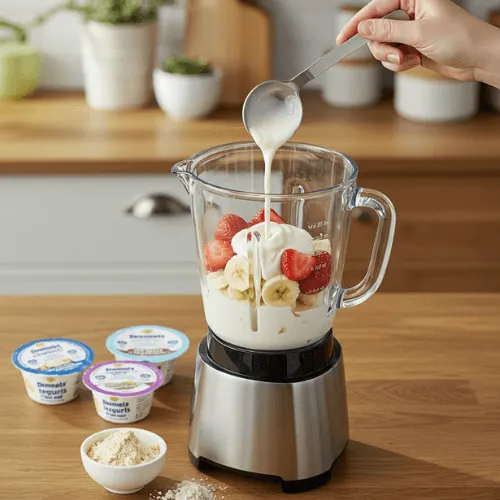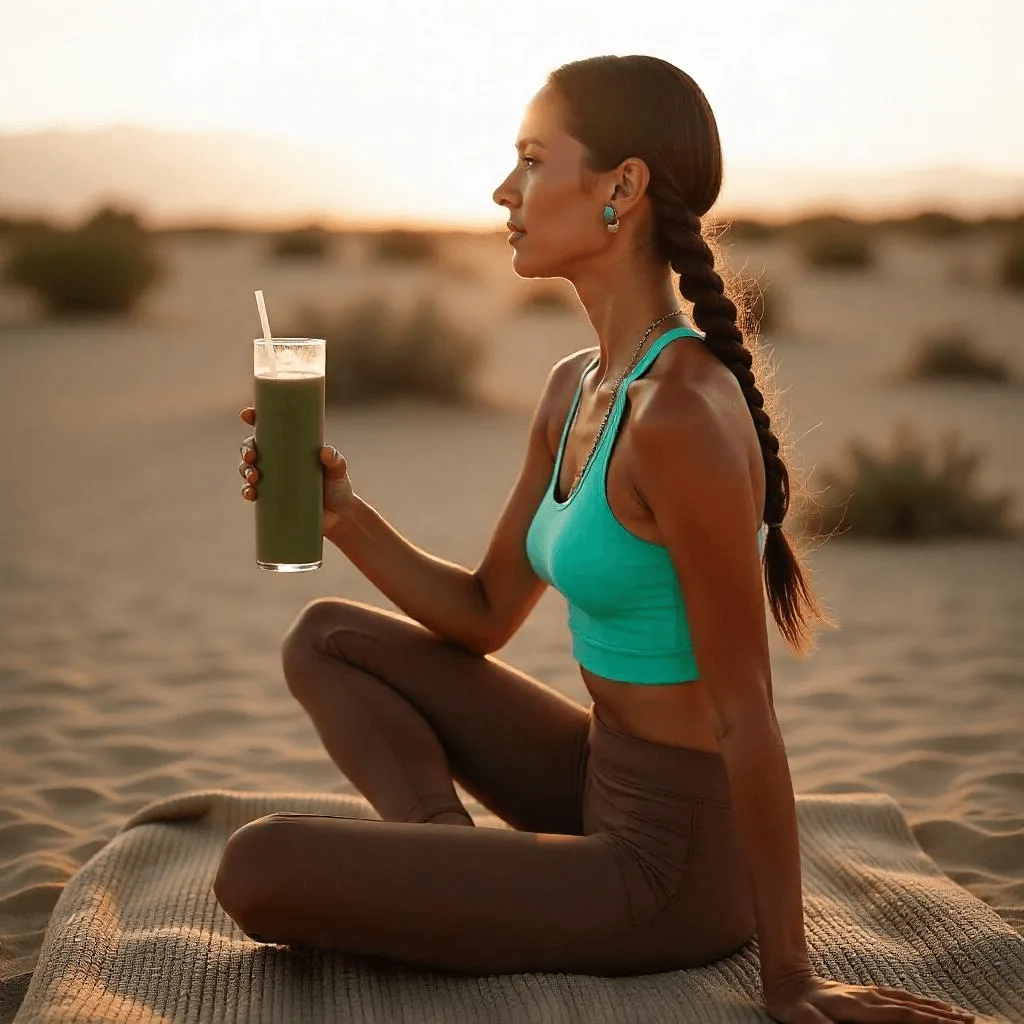How many Greek yogurt smoothies have you tried that just… missed the mark? Too thin, too sugary, or just blah? But here’s the thing—when done right, a Greek yogurt smoothie is a chef’s kiss: creamy, protein-packed, and secretly healthy (actually tasty!). It’s the MVP of breakfasts, post-gym fuel, or I-need-a-win snacks.
Because you’re not just making a smoothie—you’re making a Greek yogurt smoothie that works for you. Think: no mid-morning crashes, no weird aftertaste, and zero “why-is-this-healthy-food-so-sad” vibes. Just thick, dreamy, how-is-this-good-for-me deliciousness—in like, two minutes. So, are you set to conquer the art of the ultimate Greek yogurt smoothie? Let’s blend magic.
Table of Contents
What Makes Greek Yogurt Smoothies So Good?
Benefits of Greek Yogurt in Smoothies
- Protein-Rich: Greek yogurt offers double the protein of regular yogurt, making it a fantastic base for a breakfast or post-workout drink.
- Creamy Texture: No need for heavy cream or ice cream—you get that rich, velvety texture naturally.
- Gut-Healthy Probiotics: Help your digestion and immune system stay on point.
- Low in Sugar (when plain): Skip the added sugars in flavored brands and sweeten it naturally.
Nutritional Boost with Every Sip
You’ll find that a Greek yogurt smoothie fills you up, supports muscle growth, and satisfies cravings without spiking your blood sugar. It’s an ideal match for high-protein lifestyles, and yes, it pairs wonderfully with protein shakes and yogurt blends. Just check the USDA food database: a 3/4 cup serving of plain Greek yogurt contains about 16 grams of protein and 0 grams of added sugar.
Greek Yogurt Smoothie Recipe (Base Formula)
Ingredients Table
| Ingredient | Quantity | Notes |
|---|---|---|
| Greek yogurt | 3/4 cup | Plain, full-fat, or 2% |
| Frozen fruit | 1 cup | Berries, mango, banana |
| Milk or alternative milk | 1/2 cup | Almond, oat, or dairy optional |
| Honey or maple syrup | 1 tbsp (optional) | For sweetness |
| Ice cubes (optional) | 3-4 | For thickness |
Instructions
- Add all ingredients to your blender.
- Blend on high until smooth (about 45-60 seconds).
- Adjust consistency with more liquid or yogurt as needed.
You can easily swap in Danimals yogurt for a kid-friendly version or create a high-protein Greek yogurt shake by adding protein powder to the mix.
6 Tricks You’ll Love for the Perfect Greek Yogurt Smoothie
You know that feeling when your smoothie turns out just right—thick, creamy, and satisfying enough to keep you full? After years of sad, watery smoothie fails (and way too many expensive juice bar versions), I finally cracked the code. Here are my favorite simple tricks for Greek yogurt smoothies that taste amazing every single time:
1. Turn Your Yogurt Into “Magic Cream Cubes”
Why it works: Freezing Greek yogurt in ice cube trays gives your smoothie that perfect milkshake thickness without watering it down. It’s like nature’s soft serve!
What I do: Every Sunday, I fill an ice tray with plain Greek yogurt (the 2% fat kind for extra creaminess). Pop them out into a resealable bag, and boom—instant smoothie booster all week.
Pro tip: These are also amazing in iced coffee instead of regular ice cubes!
2. The 1-Second Flavor Lifter
My secret weapon: A tiny squeeze of lemon juice. Not enough to taste “lemony”—just enough to make all the other flavors pop. It’s similar to amplifying the taste sensations on your tongue!
When I use it most:
- Berry smoothies (makes them taste 10x fresher)
- Tropical blends (a spritz of lime with mango? Chef’s kiss)
3. The “Where Have You Been All My Life” Fiber Boost
Game changer: Adding a spoonful of old-fashioned oats before blending. They disappear completely but give the smoothest, creamiest texture while keeping me full till lunch.
Bonus hack: Soak chia seeds in your milk for 5 minutes first—they plump up into the most satisfying pudding-like texture.
4. The Decadence Trick (That’s Still Healthy)
My favorite discovery: A spoonful of almond butter doesn’t just add creaminess—it makes the whole smoothie taste like a treat. The first time I tried it, I exclaimed “Whoa!” in my empty kitchen.
Other rich add-ins I love:
- Half an avocado (sounds weird, tastes amazing)
- A square of dark chocolate (for “dessert” smoothies)
5. The Spice Drawer Makeover
Simple magic: A pinch of cinnamon transforms basic ingredients into something special. When I initially made a banana smoothie this way for my husband, he believed I had put in sugar!
My favorite spice combos:
- Cinnamon + banana = instant comfort food
- Ginger + pineapple = zingy wake-up call
- Cardamom + pear = weird but wonderful
6. Why Drink When You Can Experience Your Smoothie?
Weekend tradition: Creating thick smoothie bowls adorned with a variety of toppings. There’s something so satisfying about crunching through granola to get to the creamy goodness underneath.
Top topping combos:
- Crunchy: Granola + cacao nibs
- Chewy: Dried coconut + goji berries
- Fresh: Sliced figs + bee pollen (when I’m feeling fancy)
The Real Secret? There are no rules! Some days, I throw in leftover coffee. Sometimes, it’s just a bit of spinach (I promise, you won’t even detect the flavor). The best smoothie is the one that makes you happy.
Now tell me—what’s your can’t-live-without smoothie trick? I’m eager to discover and explore new concepts to try out! (And if you tell me you’ve never burned out a blender motor trying to crush frozen fruit… are you even really making smoothies?)


Greek Yogurt Smoothie Variations You Should Try
For Weight Loss
- Spinach
- Banana
- Plain Greek yogurt
- Flaxseed
- Unsweetened almond milk
For Energy Boost
- Greek yogurt
- Mixed berries
- Rolled oats
- Honey
- Almond butter
For Kids (with Danimals Yogurt)
- Strawberry or banana Danimals yogurt
- Banana
- Milk
- A splash of vanilla extract
These variations make it easy to keep your routine exciting. Switch up the ingredients depending on your needs for the day.
Customize Your Smoothie Like a Pro
Choose Your Sweetener
Avoid refined sugars by sweetening with:
- Honey
- Dates
- Maple syrup
- Stevia (if you’re watching carbs)
Protein Options Beyond Yogurt
- Protein powder
- Chia seeds
- Nut butters
- Hemp hearts
Combine these with Greek yogurt for the ultimate Greek yogurt shake.
Dairy-Free Alternatives
If you’re avoiding dairy, try coconut or cashew-based yogurts. These work beautifully in any yogurt smoothie recipe.
Common Mistakes to Avoid
We’ve all been there—you throw together what should be a perfect smoothie, only to end up with something too sweet, too thick, or (worst of all) weirdly warm. After plenty of trial and error, here are the biggest smoothie mistakes I’ve learned to avoid—and exactly how to fix them.
1. Using Flavored Yogurt (Sugar Bomb Alert!)
The Problem: That “strawberry banana” or “honey vanilla” Greek yogurt might seem convenient, but it’s often loaded with sneaky added sugars (sometimes more than a candy bar!).
The Fix:
- Stick to plain, unsweetened Greek yogurt (full-fat or 2% for extra creaminess).
- Sweeten naturally with ripe bananas, dates, or a drizzle of honey if needed.
- Flavor it yourself with real fruit, vanilla extract, or cinnamon.
2. Not Enough Liquid (Blender Struggle Is Real)
The Problem: Too-thick smoothies make your blender sound like it’s about to take flight—and leave you with a chunky, uneven mess.
The Fix:
- Layer liquids first (milk, water, or juice) before adding solids.
- Start with less liquid—you can always add more.
- Use hydrating ingredients like coconut water or cucumber for extra moisture without dilution.
3. Over-Blending (Say No to Warm, Separated Smoothies)
The Problem: Blending too long heats up the ingredients (especially with high-powered blenders), turning your smoothie into a weirdly frothy, lukewarm drink.
The Fix:
- Blend in short bursts (10–20 seconds max for most combos).
- Stop when it’s just smooth—no need to overdo it.
- Add ice last if you want it colder without overworking the mix.
4. Skipping Healthy Fats or Protein (Hunger Strikes Back)
The Problem: Fruit + yogurt alone might taste good, but without staying power, you’ll be ravenous by mid-morning.
The Fix:
- Add healthy fats: Nut butter, avocado, chia seeds, or flaxseed oil.
- Boost protein: Hemp seeds, silken tofu, or a scoop of unflavored protein powder.
- Pair with fiber: Oats, spinach, or psyllium husk to slow digestion.
Frequently Asked Questions (FAQ)
1. Is Greek yogurt good for smoothies?
Short answer: Yes, it’s a smoothie superstar!
- Why? It’s packed with protein (hello, staying power!), probiotics (gut health for the win), and makes your smoothie crazy creamy.
- Bonus: It’s way thicker than regular yogurt, so no sad, watery smoothies here.
2. Can you put Greek yogurt in a blender?
Short answer: Absolutely—it blends like a dream!
- No clumps, no weird texture—just velvety smoothness.
- Pro tip: Add liquids (milk, juice) first to help it blend more easily.
3. How do you make a smoothie with Greek yogurt?
My foolproof formula:
- ¾ cup Greek yogurt (plain, unsweetened)
- 1 cup frozen fruit (berries, mango, banana—pick your fave)
- Use ½ cup of liquid like milk, almond milk, or coconut water
- Optional boosts:
- 1 tbsp nut butter (for creaminess)
- 1 tsp honey or maple syrup (if you like it sweeter)
- Handful of spinach (you won’t taste it, promise!)
4. Can I use Greek yogurt instead of milk in a smoothie?
Short answer: Yes—and it’s even better!
- What happens? Your smoothie gets thicker, creamier, and higher in protein.
- Best for: Meal-replacement smoothies or when you want that milkshake texture.
5. Why can I eat Greek yogurt but not milk?
Short answer: Less lactose + probiotics = happier stomach!
- Greek yogurt has way less lactose than milk (most gets strained out).
- Live cultures, known as probiotics, aid in the digestion of lactose, enabling many individuals with lactose intolerance to manage it without issues.
6. How do I thicken a smoothie?
My top tricks (no ice needed!):
- Frozen fruit (bananas, berries, mango)
- Frozen Greek yogurt cubes (game-changer!)
- Chia seeds or oats (they soak up liquid and thicken naturally)
- Avocado or nut butter (adds creaminess + healthy fats)
7. What should I mix with Greek yogurt?
There are countless combo choices, but here are the ones I prefer:
- Classic: Berries + banana + honey
- Tropical: Mango + pineapple + coconut flakes
- Decadent: Peanut butter + cocoa powder + banana
- Green machine: Spinach + apple + ginger
- Cookie dough vibe: Oats + cinnamon + almond butter
8. Can I blend protein powder into Greek yogurt?
Short answer: 100% yes—it’s a powerhouse combo!
- Why? With its inherent protein content, Greek yogurt becomes an exceptional muscle-recovery aid when you add protein powder.
- Best pairings: Vanilla or unflavored protein powder blends seamlessly.
9. Can I blend Greek yogurt with milk?
Short answer: Yes, and it’s magic!
- What happens? You get the best of both worlds—creaminess from yogurt + smooth blendability from milk.
- Perfect for: Lighter smoothies that still taste rich.
Try this ratio: ½ cup yogurt + ½ cup milk + 1 cup frozen fruit.
Your Smoothie Just Got Smarter
Whether you’re a fitness buff, a busy parent, or just someone who loves a quick and healthy breakfast, a Greek yogurt smoothie ticks all the boxes. It’s fast, adaptable, delicious, and full of body-boosting benefits. And with these six tricks and endless variations, you’re well on your way to making smoothies that not only taste amazing but make you feel amazing too.
So what are you waiting for? Take out your blender, select your favorite ingredients, and craft the perfect blend. Both your taste buds and body will appreciate it.
Ready to try your creation? Share your favorite Greek yogurt smoothie combo in the comments below!

